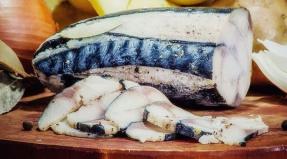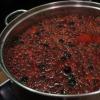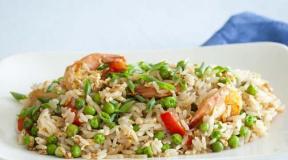How to cook chicken stomachs in a saucepan. How to cook chicken ventricles
9 months ago
By-products - both poultry and livestock - are not the most popular source of protein for modern housewives, but they taste just as good as meat if cooked correctly. One of the most affordable options for offal is chicken ventricles or navels. They perfectly complement cereals, pasta, are used in salads, casseroles. But in order to appreciate them at their true worth, you need to figure out how much to cook, how to do it correctly.
Some housewives ask themselves the question “how much to cook chicken stomachs so that they are soft?”, However, their condition depends not only on the duration of heat treatment, but also on correct preliminary preparation. If they have been frozen, they are kept in cold water until the ice completely disappears, or they are placed on the bottom shelf of the refrigerator for a similar purpose. Only then can the stomachs be rinsed under running water. Further actions:
- Make a small cut on either side and turn the offal outward. Remove the yellow film, remove the stomach contents.
- Rinse the offal thoroughly in plenty of water, check that there are no pieces of yellow film left.
- Remove fat, pipes and other unnecessary elements that may have remained from the poultry cutting process.
- Fill the prepared stomachs with cold water and leave for half an hour to wash out any debris from them (mostly sand remains there).
Also, do not forget that it is very important to choose the right offal: it should have the most uniform consistency, be free from bruises, brown and yellow spots. Also, pay attention to the smell - in raw meat it is not very pleasant, but not sour or rotten.

The fastest cooking process for this offal will turn out if you use a pressure cooker, but most housewives do not have one. For this reason, the first thing to consider is the standard pot-on-stove method:
- Cut the prepared chicken ventricles in half.
- Place in a saucepan and cover with plenty of cold water.
- Cover with a lid and bring to a boil on the hotplate at full power.
- Remove the foam, reduce the power of the hotplate to 30%, leave the lid in place.
- Boil the ventricles for 40 minutes, letting the water simmer. It is very important that the heat is kept to a minimum, otherwise the cooking will be uneven.
After the specified time has elapsed, you need to pierce the offal with a knife: if it feels tough, cook it for another 20 minutes over the same low heat. If the ventricles are still not ready, increase the cooking time by another 20 minutes... Often this time is sufficient if the stomachs are taken from broiler chickens. In adult chickens, they are tougher, so they take 1.5 hours on low heat.

Another fairly simple way to cook this offal, in which softness is guaranteed to it, is to work with a multicooker. Due to the high humidity under the lid, it warms up all products as evenly as possible, so the stomachs are tender and juicy. If desired, they can be immediately boiled with additives: onions, carrots, tomatoes or other vegetables. General algorithm of actions:
- Cut the prepared chicken ventricles in half if they are large.
- Fold into the multicooker bowl, fill with cold water so that it covers them 2 fingers high.
- Add salt and spices. Lower the lid.
- Select the Stew program and cook the chicken stomachs for 1.5 hours. During this time, the water should completely evaporate.
Often this time is enough even for the stomachs of an adult chicken, however, after the timer signal, you should check the offal for the degree of softness: if it seems to you that it is still harsh, add 20-30 minutes. After boiling, chicken stomachs can be left covered for a quarter of an hour so that they come up on their own.
Keep in mind that if the chicken ventricles are not too fresh, the cooking time will increase by 10-15 minutes as they become stiffer. And you can store the finished product in the refrigerator for 3 days, or freeze it as a semi-finished product for 3 months. In this case, after defrosting, you just need to stew it for 20 minutes, or fry or bake it.

In this article, we will talk about how to cook stomachs. Most people prefer chicken, but we will not only touch on them, because there will certainly be people who prefer a different type of meat.
How to choose stomachs?
Well, let's start, perhaps. And yet it is from chicken stomachs, which, by the way, are called by many navels. What does the cooking time of the stomachs depend on? A good cook will say that a lot depends on how old the chicken was. That is, the first factor is the age of the chicken. An experienced chef will determine quality meat by eye, but what about an ordinary man in the street? How to tell if he is buying a good product or not?
If the product is packaged, then everything is simple - just look at the date of manufacture. If you buy on the market, then you have the right to request a veterinary certificate. In large markets, no food service product is complete without veterinary certificates.
Do not buy in unverified places, because chicken ventricles are a perishable product, their shelf life is no more than two days. Be careful when choosing !!!
How much to cook chicken stomachs?
And now, finally, you have found a good and high quality product. They brought them home, and the question arose - how to cook them. First of all, like any product, the ventricles must be rinsed, preferably with cold water. The next step, as in the preparation of any meat, is to trim the veins, fat and films. The product is ready to be placed in a saucepan. We put on fire. Foam often appears during cooking. We can delete it in a way that is available to us. It is more convenient, first of all, with a slotted spoon.
It is recommended to cook over low heat. The cooking time will be one and a half hours. If you are cooking in a pressure cooker, then the time is shortened. After boiling, only 30 minutes. Here I would like to note that chicken stomachs are cooked much faster. Just half an hour over low heat under the lid, and 15 minutes in a pressure cooker.
Still, let's talk more about chicken ventricles. Chicken itself is a dietary product, and stomachs are a by-product. At the same time, tender meat has many useful substances, such as phosphorus, zinc, iron, and, most interestingly, vitamins E and B.
By the way, if you are lucky enough to purchase chicken ventricles, then it will take much less time to cook them. Literally 30 minutes over low heat and only 15 minutes in a pressure cooker.
Chicken acorns go well with almost any kind of side dish. Good luck with your experiments !!!
How much to cook other types of stomachs?
And we, perhaps, will tell you a little more about the preparation of beef, pork and turkey stomachs.
A beef stomach, which has another name - a scar, may not please any housewife when cooking, since the process, unlike chicken stomachs, is very laborious. Moreover, during cooking, it emits a rather specific unpleasant odor and the cooking time is already about three and a half hours. Not every housewife will like it.
What about pork stomachs?
In general, it is not eaten directly. It is more suitable for making brawn. What is it? - a person who is uninitiated in the culinary business will ask. By and large, this is a pressed sausage product, and it is prepared just from pork meat, bacon, tongues, liver and, accordingly, stomachs. As part of a brawn, cooking is delayed by almost 2 hours.
Well, let's talk a little about turkey
The cooking process for cooking is identical to the process described above. We pass directly to the cooking time. Turkey stomachs are boiled for 30-40 minutes, that is, even slightly less than chicken stomachs. If after cooking you want, for example, to stew stomachs with vegetables, then be prepared to spend about 20-25 minutes more before being fully cooked.
Well, people have different tastes, so we wish you successful culinary experiments !!!
- Back
- Forward
Partner news
news
Why is he stealing? Understand and react correctly
 Classmates stole a tray of pies from the dining room and had a feast. The boy hid his friend's new toy in his briefcase. A sixth grader constantly steals money from her grandmother's wallet for fashion jewelry.
Classmates stole a tray of pies from the dining room and had a feast. The boy hid his friend's new toy in his briefcase. A sixth grader constantly steals money from her grandmother's wallet for fashion jewelry.
As if changed. Poor child behavior in public
 It happens that parents are completely confident in the correct upbringing of the child - he adequately reacts to those around him, stops asking his mother what she cannot give him now, and behaves calmly in public places. Mom is happy and even somewhat proud of her teaching abilities.
It happens that parents are completely confident in the correct upbringing of the child - he adequately reacts to those around him, stops asking his mother what she cannot give him now, and behaves calmly in public places. Mom is happy and even somewhat proud of her teaching abilities.
Love of order in a child? Making dreams come true
 Who does not dream that a child from an early age fell in love with cleanliness and was able to easily put things in order in the house. For this, parents put a lot of effort, spend a lot of time and nerves, but rarely come out as complete winners in the fight against disorder.
Who does not dream that a child from an early age fell in love with cleanliness and was able to easily put things in order in the house. For this, parents put a lot of effort, spend a lot of time and nerves, but rarely come out as complete winners in the fight against disorder.
 Carefully! The first grader is doing his homework. Or how to maintain interest in learning.
Carefully! The first grader is doing his homework. Or how to maintain interest in learning.
Autumn is already in full swing, schoolchildren are headlong into their studies, have entered the rhythm. But the first graders were attacked by despondency. The bright summer impressions have been forgotten, the fuss around the first grade training has subsided, congratulations on the Day of Knowledge have gone off. Yesterday's preschoolers did not even suspect that lessons would have to be done every day, that cartoons and games would be so limited, and mom could be so strict.
Problems of adolescents: how to behave as parents
 Adolescence is one of the most difficult times for parents. But behind the screams, quarrels and anger lies a banal misunderstanding. No wonder they say that the problem of "fathers and children" is still relevant. After all, every teenager goes through a difficult path before accepting and realizing mistakes, becoming an adult, having children and trying to protect them from failure. History repeats itself with each new generation.
Adolescence is one of the most difficult times for parents. But behind the screams, quarrels and anger lies a banal misunderstanding. No wonder they say that the problem of "fathers and children" is still relevant. After all, every teenager goes through a difficult path before accepting and realizing mistakes, becoming an adult, having children and trying to protect them from failure. History repeats itself with each new generation.
How to cook chicken stomachs
Rinse chicken stomachs under warm water, then dry them. Cut off excess fat, veins and various films from chicken stomachs. Now you can put them in a saucepan with cold water and put them on the fire to cook. Young chicken stomachs will cook much faster than old ones. The longer you cook the chicken stomachs, the softer and softer they will be.
How much to cook?
Cooking time for chicken stomachs is 1.5 hours over low heat and with the lid closed. During cooking, a foam will form, which will need to be removed periodically.
Chicken stomachs can also be cooked in a skillet, then your cooking time will be halved. The duration of the cooking is 30 minutes after the water boils. It is recommended to store the stomachs for no more than 2 days.
In stores, it is better to buy stomachs not frozen, but chilled, in this form they retain more useful properties. The structure of the stomach in a chicken consists of four muscle layers directed in different directions. Before cooking, be sure to wash the stomachs, remove fat and film. The useful properties of stomachs include B vitamins, vitamin E, trace elements (zinc, phosphorus, potassium, iron), as well as folic acid. The energy value of the meat product is 130 kcal per 100 grams.
How to cook chicken stomachs
Boiled buckwheat is perfect for garnish with this dish. It turns out very tasty and satisfying. We have to:
1. Chicken ventricles - 400 grams
2. Ketchup or tomato paste - 1 piece
3. Buckwheat - 150 grams
4. Onions - 1 piece
5. Vegetable oil
6. Salt, pepper - to taste
Remove the fat from the ventricles and remove the foil, cut into medium-sized pieces on a plank. We put a pot of water on the fire, add the ventricles and bring to a boil. Add salt and cook after boiling for 25 minutes.
We put another pot of water on the fire, bring to a boil, salt and add. Cook for 15 to 20 minutes.
Preheat the pan, add vegetable oil and lay out the cooked ventricles. Cook for 5 minutes, after that, spread the fried chicken stomachs, finely chopped onion and simmer for 10 minutes.
Dissolve tomato paste in a little water, then pour into a frying pan with ventricles and let simmer a little. Then add buckwheat, add spices and mix everything. Bon Appetit!
Chicken ventricles are dearly loved by many housewives. And there is a reason. Dishes from the ventricles are tasty and healthy, they are easy to prepare, and they do not damage the budget. But the trouble is, not everyone knows how to properly cook chicken ventricles; cook them so that they are tender, soft and aromatic, without losing their taste and nutritional properties. Alas, but quite often the housewives, who are not yet fully accustomed to the kitchen, give up and completely exclude the ventricles from the home menu, considering them too tough and tasteless. And completely in vain. Today we invite you to work with us to figure out and remember how to cook chicken ventricles so that they always turn out soft and tasty, delight you and your family with their aroma and become an obligatory item on your daily menu.

Like many other organ meats, chicken stomachs are not only delicious but also extremely healthy. The muscle tissue of the ventricles is rich in complete animal protein, contains iron, zinc, phosphorus and potassium, and dishes prepared from the ventricles can serve as a good source of B vitamins, vitamin E and folic acid. At the same time, the low fat content of the ventricles makes them an important product in diets aimed at weight loss. The internal epithelium of the chicken ventricles, the so-called "gastric films" popular rumor ascribes medicinal properties, considering them an extraordinary and effective medicine for stomach and intestinal disorders. But, of course, you and I are more interested in the taste, culinary qualities of chicken ventricles.

So what kind of dishes, you ask, can be made from chicken stomachs? Oh yes there are hundreds of them! The ventricles are boiled and stewed, baked and fried, using them alone or in combination with other offal. Soup noodles with giblets and ventricles baked with cheese, stewed chicken ventricles with sour cream and ventricles fried in breadcrumbs, the most delicate stew with chicken ventricles and delicious salads with offal, and you can't list everything. It greatly expands the culinary use of the ventricles and their excellent compatibility with other products. The ventricles will give cereals and pasta a special taste and aroma, the ventricles will add satiety to vegetable dishes; mushrooms will make your dish of chicken ventricles more delicious, and fermented milk products will give the ventricles additional softness and tenderness. Add to this the excellent combination with many spices, herbs and spices, and you yourself will be surprised at what an abundance of new shades of taste and aroma can play the most, at first glance, unpretentious dish made from chicken ventricles.
We will tell you how to cook chicken ventricles. And we offer you the most important tips and secrets and interesting recipes that will definitely tell you how to cook chicken ventricles.
 1. When choosing chicken stomachs for your dish, pay special attention to their freshness. The chilled ventricles are the softest and tastiest. Their shelf life is short and is only 48 hours. Be sure to touch and smell the ventricles before purchasing. Fresh ventricles will be elastic, slightly moist to the touch, while possessing a pleasant, sweetish smell. If you are offered too soft, flabby ventricles, slippery to the touch and embarrassing with a sour, unpleasant smell, give up the purchase, because a tasty dish from stale ventricles will not work.
1. When choosing chicken stomachs for your dish, pay special attention to their freshness. The chilled ventricles are the softest and tastiest. Their shelf life is short and is only 48 hours. Be sure to touch and smell the ventricles before purchasing. Fresh ventricles will be elastic, slightly moist to the touch, while possessing a pleasant, sweetish smell. If you are offered too soft, flabby ventricles, slippery to the touch and embarrassing with a sour, unpleasant smell, give up the purchase, because a tasty dish from stale ventricles will not work.

2. Before you start preparing your chosen dish, the chicken ventricles must be properly prepared. If you purchased frozen stomachs, defrost them in advance by placing them in the lower compartment of the refrigerator for 10 - 12 hours. This slow, gentle defrosting method will allow you to fully preserve the taste and nutritional qualities of the product. It often happens that a gastric film remains on the inner surface of the stomachs, it must be completely removed. Examine the ventricles carefully for bile leaks. Be sure to cut off pieces of stomachs on which yellowish bile streaks will appear, because even a small amount of bile can completely spoil your dish with its bitterness. Rinse the cleaned ventricles thoroughly from all sides under running warm water.
3. For many salads and appetizers, you may need boiled chicken gizzards. To make the boiled ventricles tender, soft and juicy, you need to follow a few simple rules. Put the cleaned and thoroughly washed chicken ventricles in a deep bowl, cover with cool water and let stand for two to three hours. Drain the water, rinse the ventricles again and put in a deep saucepan with a thick bottom. Fill the ventricles with hot water so that it covers them at least five centimeters. Bring the water to a boil over high heat, remove the foam thoroughly, reduce the heat to medium, cover the saucepan with a lid and cook the ventricles for 20 minutes. Then add bay leaves, a few black peppercorns and salt to taste. Cook everything together for another 20 to 30 minutes. Remove the pan from heat and let the ventricles cool in the broth.
 4. A simple appetizer of chicken ventricles with onions is very tasty. Boil until tender, refrigerate and cut into thin slices 700 gr. ventricles. Cut two small red onions into half rings. In a deep bowl, combine the ventricles and onions, add ½ teaspoon of brown sugar, stir. In a small skillet, heat four tablespoons of olive oil, add two minced garlic cloves and ½ teaspoon of red pepper flakes. Mix everything quickly, remove from heat and immediately pour into the ventricles with onions. Add one tablespoon of soy sauce and one tablespoon of good wine vinegar. Stir and refrigerate for six hours. Sprinkle with finely chopped cilantro and green onions before serving.
4. A simple appetizer of chicken ventricles with onions is very tasty. Boil until tender, refrigerate and cut into thin slices 700 gr. ventricles. Cut two small red onions into half rings. In a deep bowl, combine the ventricles and onions, add ½ teaspoon of brown sugar, stir. In a small skillet, heat four tablespoons of olive oil, add two minced garlic cloves and ½ teaspoon of red pepper flakes. Mix everything quickly, remove from heat and immediately pour into the ventricles with onions. Add one tablespoon of soy sauce and one tablespoon of good wine vinegar. Stir and refrigerate for six hours. Sprinkle with finely chopped cilantro and green onions before serving.

5. It is a little more difficult to prepare the original piquant chicken ventricle salad in the Korean recipe. But this salad is well worth the effort! Boil until tender, cool and cut into 400 gr. Strips. chicken ventricles. Heat 1 tbsp in a skillet. a spoonful of vegetable oil, add one large onion, cut into half rings, and fry until golden brown. Then add the ventricles and fry everything together, stirring occasionally, for a couple more minutes. Remove from heat. Peel and grate two medium potatoes with a Korean carrot grater or cut into very thin strips. Boil the potato strips in boiling water for three minutes, then drain in a colander, rinse with cold water and dry slightly. Prepare the dressing separately. To do this, mix 3 tbsp. spoons of rice or white wine vinegar, 2 tbsp. tablespoons of soy sauce, 2 teaspoons of sesame oil, two chopped cloves of garlic, ½ teaspoon of powdered sugar, salt and red pepper to taste. Transfer the ventricles with onions to a salad bowl, add boiled potato strips and 3 tbsp. tablespoons of finely chopped cilantro greens. Pour the dressing over the salad, stir gently and let sit in a cool place for two hours.
 6. It is quite easy to cook the most tender chicken ventricles stewed in sour cream sauce. Peel, rinse and cut into small pieces of 500 g. chicken ventricles. Heat 2 tablespoons in a skillet. tablespoons of butter. Once the butter has finished sizzling, add the ventricles and fry them over medium heat until golden brown. Then add one glass of chicken stock, salt and black pepper to taste, cover the pan and simmer the ventricles over low heat for 30 minutes. After the time has passed, add 150 gr. sour cream and 50 gr. low-fat natural yogurt, mix thoroughly and heat over the lowest heat for five minutes. Remove from heat and let it brew for another 10 minutes.
6. It is quite easy to cook the most tender chicken ventricles stewed in sour cream sauce. Peel, rinse and cut into small pieces of 500 g. chicken ventricles. Heat 2 tablespoons in a skillet. tablespoons of butter. Once the butter has finished sizzling, add the ventricles and fry them over medium heat until golden brown. Then add one glass of chicken stock, salt and black pepper to taste, cover the pan and simmer the ventricles over low heat for 30 minutes. After the time has passed, add 150 gr. sour cream and 50 gr. low-fat natural yogurt, mix thoroughly and heat over the lowest heat for five minutes. Remove from heat and let it brew for another 10 minutes.

7. An easy-to-prepare dish of chicken ventricles stewed with beer is very tasty and satisfying. Peel off films, rinse thoroughly and cut into thick 500 gr slices. chicken stomachs. In a deep skillet, heat 1 tbsp together. a spoonful of vegetable oil and 1 tbsp. a spoonful of butter. Add one finely chopped onion and fry until translucent for a couple of minutes. Then add the ventricles and fry, stirring occasionally, for five minutes. Sprinkle everything with one tablespoon of flour, stir and fry for another couple of minutes. Season with salt and pepper to taste, stir, pour in one glass of light beer and ½ mill of chicken broth. Add 1 tbsp. a spoonful of white wine vinegar, ½ tbsp. tablespoons of sugar, 1 teaspoon of mustard. Stir, bring to a boil, reduce heat to very low and simmer the ventricles, covered, stirring occasionally, for 30 minutes. Add more chicken stock if needed. Serve with boiled potatoes and fresh vegetables.
 8. Stewed chicken ventricles with vegetables according to a summer recipe will delight you with their softness and juiciness. Thoroughly clean and rinse one kilogram of chicken ventricles in running water. In a deep frying pan, heat one tablespoon of vegetable oil, add the ventricles, lightly salt and quickly fry over high heat until golden brown. Then add one glass of chicken broth or water and simmer the ventricles, covered, over medium heat for half an hour. In the meantime, prepare the vegetables: cut one carrot into thin strips, cut one onion into half rings, cut one small zucchini into cubes, and one sweet pepper into long strips, 200 gr. disassemble broccoli into inflorescences and boil in slightly salted water until half cooked within 5 minutes after boiling. After half an hour, add onions and carrots, a pinch of black pepper and dried marjoram to the ventricles. Stir and simmer everything together for 10 minutes, then add the courgettes and bell peppers, mix thoroughly again, and simmer, stirring occasionally, for another 15 minutes. Then add boiled broccoli and one chopped garlic clove, mix gently and simmer everything together over low heat, covered for another 5 to 7 minutes, until tender. Remove from heat and let it brew for 10 minutes. Sprinkle with finely chopped herbs of your choice before serving.
8. Stewed chicken ventricles with vegetables according to a summer recipe will delight you with their softness and juiciness. Thoroughly clean and rinse one kilogram of chicken ventricles in running water. In a deep frying pan, heat one tablespoon of vegetable oil, add the ventricles, lightly salt and quickly fry over high heat until golden brown. Then add one glass of chicken broth or water and simmer the ventricles, covered, over medium heat for half an hour. In the meantime, prepare the vegetables: cut one carrot into thin strips, cut one onion into half rings, cut one small zucchini into cubes, and one sweet pepper into long strips, 200 gr. disassemble broccoli into inflorescences and boil in slightly salted water until half cooked within 5 minutes after boiling. After half an hour, add onions and carrots, a pinch of black pepper and dried marjoram to the ventricles. Stir and simmer everything together for 10 minutes, then add the courgettes and bell peppers, mix thoroughly again, and simmer, stirring occasionally, for another 15 minutes. Then add boiled broccoli and one chopped garlic clove, mix gently and simmer everything together over low heat, covered for another 5 to 7 minutes, until tender. Remove from heat and let it brew for 10 minutes. Sprinkle with finely chopped herbs of your choice before serving.
9. Appetizing aroma and pleasant taste with a slight sourness will give you chicken gizzards baked with prunes. Soak 500 grams in cool water for three hours in advance. pitted prunes. Thoroughly clean one kilogram of chicken ventricles, rinse and cut into large pieces. Heat one tablespoon of vegetable oil in a frying pan, add one, cut into half rings, onion and fry until golden brown. Then add the ventricles, season with salt and pepper to taste, and fry until golden brown. Put half of the prunes in a greased baking dish, put the ventricles fried with onions on top of the prunes, cover with the remaining prunes on top. Cut two small carrots into thin rings and place on top of the prunes. Mix ½ cup chicken stock, ½ cup sour cream, and ½ cup low-fat yogurt separately. Pour this mixture over the ventricles with prunes and bake in an oven preheated to 180⁰ for 40 minutes.

10. It is quite easy to prepare the most aromatic chicken gizzards baked with cheese. Clean in advance, rinse and boil one kilogram of chicken ventricles until tender. Cut the ventricles into large pieces, put them in a pickling bowl, add one onion, cut into half rings, one carrot, cut into thin strips, one teaspoon of suneli hops, salt and black pepper to taste. Pour everything with one liter of kefir or low-fat yogurt and leave to marinate for one hour. Transfer the marinated ventricles to a greased baking dish, pour over the remaining marinade and sprinkle with 150 gr. finely grated Parmesan. Sprinkle everything with a little melted butter and bake in a preheated 180⁰ oven for 20 minutes. Sprinkle with finely chopped cilantro and green onions before serving.
And the site "Culinary Eden" on its pages is always glad to offer you even more interesting ideas and proven recipes that will definitely tell you how to cook chicken stomachs.
Recently, dishes with chicken stomachs have become increasingly popular. And this is not at all surprising, because properly cooked by-products are not only very tasty, but also contain a minimum amount of calories, so they can be eaten even during a diet. Also, chicken stomachs contain a large amount of beneficial trace elements and have an interesting taste.
How to cook chicken stomachs so they are soft?
If you decide to cook some kind of dish from chicken stomachs, first you need to know how to choose them. When buying offal, pay particular attention to their freshness. Chilled stomachs are very tasty and soft, while their shelf life is no more than 48 hours.
Before buying, you need to not only smell, but also touch the stomachs. Fresh offal should be slightly moist, firm and have a pleasant, slightly sweet aroma. In the event that the store offers you very flabby, soft, how many stomachs that have an unpleasant sour smell, it is best to refuse to buy, since you cannot prepare a tasty dish from stale offal.
Before proceeding directly to the preparation of dishes with chicken stomachs, they must be properly prepared. If you purchased a frozen product, then you must defrost it in advance - place it in the lower compartment in the refrigerator and leave it for about 10 hours. Of course, this defrosting process is very slow, but it makes it possible to fully preserve all the nutritional and taste qualities of offal.
Quite often, a thin film remains on the inside of the stomachs, which must be removed without fail. Then carefully inspect the product to ensure that no bile drips remain on it. If some of the pieces have yellowish bile streaks, you need to carefully cut them off. The fact is that even a small amount of bile can completely ruin the taste of the whole dish, which will be very bitter. As soon as the process of cleansing the ventricles is completely completed, they must be thoroughly rinsed under running warm water.
As a rule of thumb, to prepare more appetizers and salads, you will need to use boiled chicken stomachs. If you decide to boil offal to make them juicy, soft and tender, you must follow a few simple rules for their preparation. The washed and cleaned ventricles must be transferred to a deep bowl, then filled with clean water (cool) and left for 2-3 hours.
After the specified time, the water is drained, and the ventricles are washed again and transferred to a saucepan with a double bottom. Fill the offal with hot water so that it completely covers them and is about 5 cm above their level. The saucepan is placed over high heat and brought to a boil. Then the foam that appears is removed, the fire is screwed on a little and the pan is covered with a lid. The ventricles are boiled for about 20 minutes, then a couple of black peppercorns and bay leaves are added, the broth is salted to taste. Everything is cooked together for another 20 minutes, then the pan is removed from the stove and the stomachs are left to cool in the broth.
How much do chicken stomachs need to be boiled?
Cleaned and well-washed chicken ventricles should be boiled in lightly salted water until tender. After about 20-30 minutes, using a slotted spoon, they are taken out of the saucepan and can be used to prepare various dishes. Stewed chicken ventricles are very tasty, tender and quite satisfying.
During the preparation of these offal, a wide variety of spices and seasonings can be used, since the stomachs perfectly absorb the taste and aroma of the spices. An ideal side dish for stewed ventricles will be various cereals, potatoes, and pasta.
To prepare some dishes, chicken stomachs do not need to be boiled, but in this case, the cooking time will take about an hour. All ingredients must be stewed until the product is fully cooked. During cooking, it is necessary to periodically add water in small portions.
Chicken stomach soup: recipes
Chicken stomach soup is a very tasty and satisfying dish traditionally seasoned with noodles and potatoes. To add spice to the dish, tomato and mustard are added during cooking.
Noodle soup with chicken ventricles

Composition:
- Ground pepper - to taste
- Mustard - 1 tbsp l.
- Salt - 1-1.5 tsp.
- Vermicelli - 3 tbsp. l. (3 handfuls)
- Basil, oregano, parsley, dill - to taste
- Potatoes - 3 pcs.
- Tomatoes - 1 pc.
- Onions - 1 pc.
- Carrots - 1 pc.
- Chicken stomachs - 600 g
Preparation:
- First, we prepare the ventricles - clean and wash thoroughly with plenty of warm water.
- We put a saucepan on the stove and pour water into it, as soon as the liquid boils, lay out the prepared ventricles.
- Cook the broth under a closed lid over low heat for 50-60 minutes, periodically removing the foam.
- While the broth is boiling, we prepare the vegetables - peel the carrots and onions. Cut the onion into small cubes. Grind the carrots on a grater (coarse).
- We put a frying pan on the stove, heat it up, pour a small amount of vegetable oil and lay out the prepared vegetables. We immediately season the vegetables with a pinch of salt, as they should have time to let the juice flow.
- Fry vegetables over low heat for about 10 minutes, stirring occasionally so as not to burn.
- Then add the tomato, cut into small cubes beforehand, to the vegetables, mix and fry everything together for about 5 minutes more.
- Peel potatoes and cut into thin strips.
- While the broth is cooking, leave the potatoes in cold water, otherwise it will darken.
- After about an hour of cooking the chicken ventricles, put the sautéed vegetables in a saucepan, put the potatoes.
- Cook the soup with potatoes for about 10 minutes, then lay out the noodles and cook all together for 7 minutes, until the noodles are completely ready.
- Almost at the very end of cooking, add salt, mustard, pepper and dry herbs.
- Vermicelli soup with chicken stomachs is completely ready, you can serve it to the table with the addition of mayonnaise or sour cream.
Buckwheat soup with chicken ventricles

Composition:
- Black pepper - to taste
- Bay leaf - 1 pc.
- Green onions - 1 bunch
- Buckwheat - 3.5-4 tbsp. l.
- Salt - 1 pinch
- Sunflower oil - 3-4 tbsp l.
- Carrots - 1 pc.
- Purple onion - 1 pc.
- Sweet yellow onion - 1 pc.
- Potatoes - 3-4 pcs.
- Water - 1.7-2 liters.
- Chicken stomachs - 400-420 g
Preparation:
- We wash the stomachs in warm water, cleanse, wash again and cut into small cubes.
- Transfer the prepared offal into a deep saucepan and fill it with water (cold). We put the pan on the stove and let the liquid boil. Cook the stomachs for about 20 minutes, after boiling the water.
- While the ventricles are being prepared, peel the potatoes and cut them into not very large cubes.
- Peel the onions and carrots and rinse with cold water.
- Wash the pepper and remove the seeds.
- Chop carrots, peppers and onions.
- We put a frying pan on the stove, heat it up and pour in a little vegetable oil.
- As soon as the oil is hot, lightly fry the carrots and onions in it until the vegetables acquire a pleasant golden hue. Then turn off the stove and remove the pan from the stove.
- Add a little salt to the broth with the ventricles.
- Put the potatoes in a saucepan with broth and let it boil.
- As soon as the broth starts to boil, tighten the fire and boil for about 10 minutes more.
- We wash the buckwheat with cold water and add to the saucepan.
- Let the soup boil and cook until the buckwheat and potatoes are fully cooked.
- As soon as the buckwheat and potatoes are completely cooked, add the vegetable fry to the soup, cook for about 5 minutes.
- Remove the pan from the stove, then add the pre-washed and chopped green onions, bay leaves and peppers to the soup.
- After about 10 minutes, remove the bay leaf and you can serve the soup to the table.
- The soup turns out to be very tasty in a few hours, when it is well infused.
- If desired, you can serve the soup with the addition of a few tablespoons of sour cream.
Chicken stomachs are great for everyday cooking. They can be stewed, fried, added salads, and aromatic soups can be cooked with them. The product is distinguished not only by its peculiar pleasant taste, but also by its low price. This allows you to introduce affordable, but very appetizing dishes into the family diet!
Read also ...
- Recipes for making coffee with ice cream at home
- Strawberry panna cotta - a classic of world culinary What is panna cotta with strawberries
- Cream of curd cheese for cake - the best recipes for impregnating and decorating dessert
- Profiterole recipe and three original custard recipes Protein cream for profiteroles



















